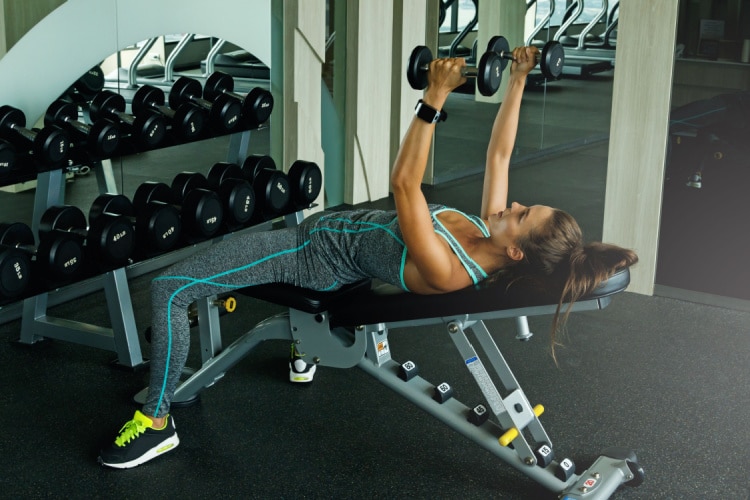If your chest day has hit a plateau, it might be time to rethink your pressing angles. The decline dumbbell bench press is often overlooked, yet it plays a major role in developing the lower portion of the chest. This unique movement shifts the load toward the lower pectorals, while still engaging the shoulders and triceps. When done correctly, it builds strength, size, and balance across your upper body.
Let’s explore the top variations of the decline dumbbell bench press that can elevate your results and keep your workouts fresh.
Why the Decline Angle Matters
Decline pressing changes the position of your chest muscles relative to the weight. While flat and incline presses hit the upper and mid-chest more directly, the decline angle targets the lower chest fibers. For a complete, well-developed chest, incorporating all angles is key.
Using dumbbells increases the challenge by requiring stability and allowing a greater range of motion. It also helps reduce muscle imbalances because each arm works independently.
Classic Decline Dumbbell Bench Press
This is the standard version and a great place to start.
- Set your bench at a 15 to 30 degree decline.
- Secure your feet to prevent sliding.
- Hold a dumbbell in each hand, lower them slowly to your chest, and press back up while squeezing your pecs.
Focus on controlled movement and don’t rush the reps. The goal is to feel the stretch at the bottom and the contraction at the top.
Decline Dumbbell Fly
This variation isolates the chest more and reduces triceps involvement.
- From the decline position, start with arms extended above your chest, dumbbells facing each other.
- Slowly open your arms in a wide arc, keeping a slight bend in your elbows.
- When you feel a good stretch in your chest, bring the weights back to the starting position.
This is excellent for chest activation and muscle control. Use lighter weights to avoid strain on your shoulders.
Decline Dumbbell Press with Wrist Rotation
Add a twist to your press to increase chest engagement.
- Begin the same way as a standard decline dumbbell press.
- As you press up, rotate your wrists so that your palms face each other at the top.
- Rotate back to the starting grip as you lower.
The wrist rotation helps activate the inner and outer parts of the chest differently. It also challenges your control during the movement.
Single-Arm Decline Dumbbell Press
This version builds unilateral strength and improves muscle balance.
- Perform the press using only one dumbbell while the other arm remains at your side.
- Keep your core tight to prevent rotation or arching.
- Switch arms after each set.
This not only targets your chest but also works your core and shoulder stability more than the traditional press.
Alternating Dumbbell Press
Instead of pressing both weights together, alternate arms.
- Lower one dumbbell while the other stays extended.
- Press back up and then repeat with the opposite arm.
This keeps your core engaged and adds time under tension to your chest muscles. It’s also great for improving coordination and balance between sides.
Decline Neutral Grip Dumbbell Press
A neutral grip (palms facing each other) places less stress on the shoulders.
- Hold the dumbbells with your palms facing inward.
- Lower the weights with control and press them up while maintaining the neutral grip.
This variation is a joint-friendly alternative for those with shoulder discomfort during traditional pressing.
Tempo Decline Dumbbell Press
Changing the speed of the lift increases intensity.
- Lower the dumbbells over three seconds.
- Pause at the bottom for one second.
- Press up quickly.
This controlled tempo increases time under tension, which is critical for hypertrophy. It also improves form and mind-muscle connection.
Drop Set Decline Dumbbell Press
Push past fatigue with drop sets.
- Start with a heavy weight for 6 to 8 reps.
- Immediately switch to a lighter weight and continue pressing.
- Perform 2 to 3 drop rounds without rest.
This technique shocks the muscles and boosts metabolic stress, a key factor for muscle growth.
Incorporating Variations into Your Workout
How and when you use these variations depends on your training goals.
For muscle size:
- Use 3 to 4 sets of 8 to 12 reps.
- Add decline flys or rotation presses to finish off the chest after your main lifts.
For strength:
- Stick to the basic decline press with heavier weights and lower reps (4 to 6).
- Use the alternating press as a secondary movement to build stability and control.
For endurance and conditioning:
- Add tempo presses and drop sets at the end of your chest workout.
Avoid using too many variations in one session. Rotate them weekly or bi-weekly to keep your training fresh and effective.
Mistakes to Avoid
Even with these variations, proper form is essential.
- Don’t flare your elbows too wide. Keep them at about a 45-degree angle.
- Avoid bouncing the dumbbells off your chest.
- Keep your core tight and your back supported by the bench.
- Control both the lift and the lowering phase to prevent injury and maximize engagement.
Final Thoughts
The decline dumbbell bench press and its variations are powerful tools for building a strong, balanced chest. They offer targeted lower pec development, challenge your coordination, and help prevent training plateaus. Whether you’re chasing size, strength, or better muscle control, adding these moves to your workout routine can take your chest training to the next level.










